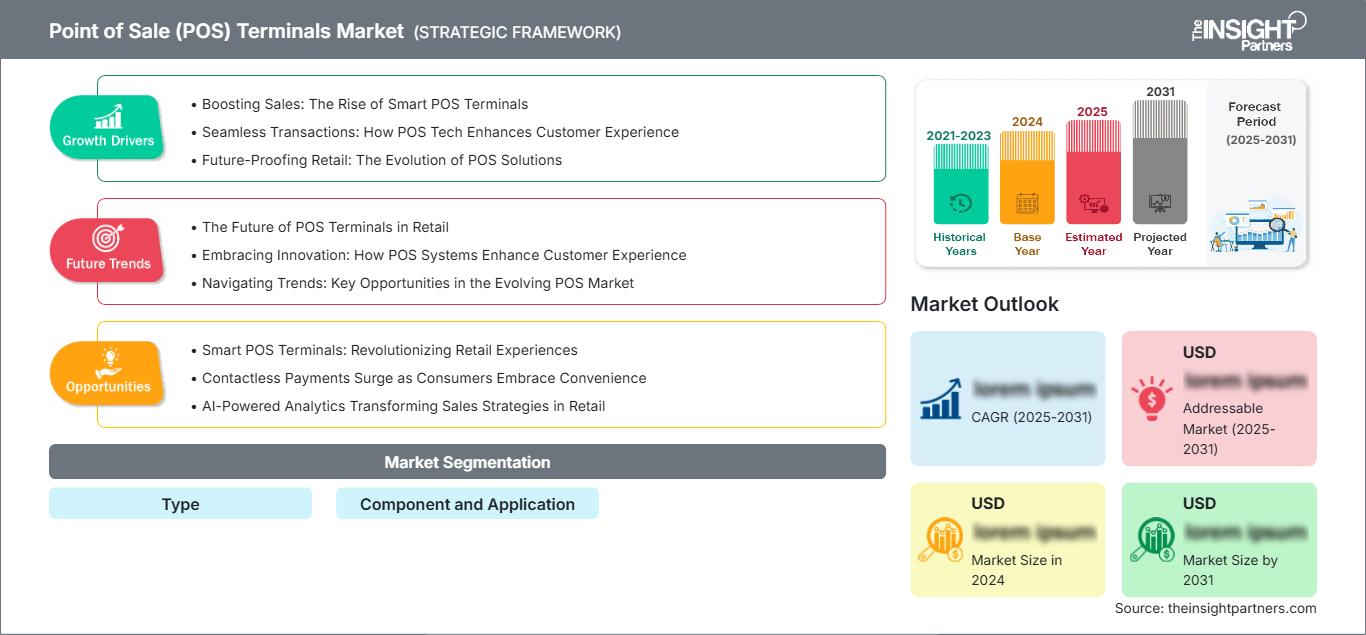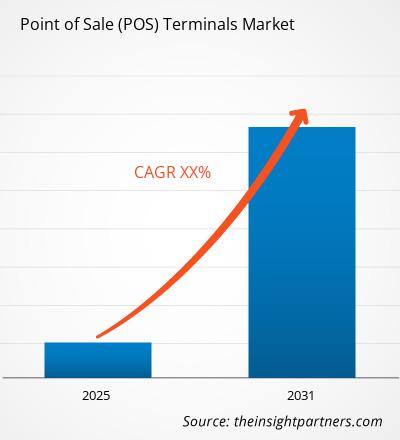Am Point of Sale (POS) wird die Transaktion abgeschlossen und der Kunde bezahlt die gekaufte Ware oder die in Anspruch genommene Dienstleistung an den Händler. Der Händler erstellt hier eine Rechnung oder berechnet den vom Kunden zu zahlenden Betrag und bietet verschiedene Zahlungsoptionen an. Nach Zahlungseingang stellt der Händler einen Beleg aus. POS-Terminals bieten ein breites Anwendungsspektrum, z. B. für Bestandsverwaltung, Rechnungsdruck, Treueprogramme und Zahlungen. Aufgrund des höheren Return on Investment (ROI) von POS-Systemen hat sich der Markt für POS-Terminals in den letzten Jahren rasant entwickelt. Im Vergleich zu herkömmlichen Systemen sind die verbesserten POS-Systeme langlebiger und zuverlässiger, was zu geringeren Betriebskosten führt und somit die Nachfrage nach POS-Lösungen bei kleinen und mittleren Unternehmen erhöht. Das Aufkommen mobiler POS-Terminals (mPOS) hat die bestehenden Zahlungs- und Transaktionstechniken aufgrund ihrer erweiterten Funktionen wie besserem Benutzererlebnis und Mobilität auf den Kopf gestellt. Mit mPOS können Finanztransaktionen direkt beim Kunden durchgeführt werden, was wiederum das Kundenerlebnis verbessert. Zudem sind die Anschaffungskosten von mPOS im Vergleich zu herkömmlichen festen POS-Systemen niedriger, was zu einer Nachfrage bei mittleren und kleinen Unternehmen führt. Der Einzelhandel und das Gastgewerbe erleben aufgrund des verbesserten ROI und der erhöhten Nachfrage nach Kundenanalysefunktionen einen rasanten Anstieg der Nachfrage nach mPOS-Lösungen. Mit dem technologischen Fortschritt ist der Markt für mPOS und drahtlose Terminals deutlich gewachsen. Diese Systeme bieten viele wichtige Vorteile wie Benutzerfreundlichkeit, geringere Bereitstellungskosten und Mobilität. Außerdem hat die Verwendung von Smartphones und Tablets in Büros zugenommen, weshalb mPOS wirtschaftlicher ist als die Entscheidung für feste POS-Terminals. Der angemessene Preis für drahtlose Kommunikationstechnologien und die Nutzung von Terminals mit TCP/IP-Konnektivität sind Merkmale, die das Wachstum von mPOS-Terminals begünstigen. Der globale Markt für POS-Terminals ist nach Typ in drahtlose, mobile POS und feste POS unterteilt. Des Weiteren ist der globale Markt für POS-Terminals nach Komponenten in POS-Software, POS-Hardware und POS-Dienste unterteilt. Zudem lässt sich der globale Markt für POS-Terminals nach Anwendung in Einzelhandel, Unterhaltung, Behörden, Lager/Vertrieb, Gastgewerbe, Restaurants, Transport und andere unterteilen. Der globale Markt für POS-Terminals ist nach Regionen in Nordamerika, Europa, Asien-Pazifik, Südamerika sowie Naher Osten und Afrika unterteilt. Nordamerika dominiert den Markt für POS-Terminals, gefolgt von APAC. Im Asien-Pazifik-Raum wird aufgrund der Zunahme kleiner und mittlerer Unternehmen und sinkender Betriebskosten ein hohes Wachstum erwartet. Die Existenz einer riesigen Softwarebasis in China und Indien kann sich aufgrund der Verbreitung im Einzelhandel positiv auf das Softwaresegment auswirken. Zu den wichtigsten Akteuren auf dem Markt für POS-Terminals zählen unter anderem Panasonic Corporation, Ingenico SA, MICROS Systems Inc., VeriFone Systems Inc., NEC Corporation, Hewlett-Packard Development Company LP, PAX Technology Limited, Cisco Systems Inc., Toshiba Corporation und Samsung Electronics Co. Ltd.
Sie erhalten kostenlos Anpassungen an jedem Bericht, einschließlich Teilen dieses Berichts oder einer Analyse auf Länderebene, eines Excel-Datenpakets sowie tolle Angebote und Rabatte für Start-ups und Universitäten.
Markt für Point-of-Sale-Terminals (POS): Strategische Einblicke

- Holen Sie sich die wichtigsten Markttrends aus diesem Bericht.Dieses KOSTENLOSE Beispiel umfasst Datenanalysen, die von Markttrends bis hin zu Schätzungen und Prognosen reichen.
Regionale Einblicke in den Markt für Point-of-Sale-Terminals (POS)
Die Analysten von The Insight Partners haben die regionalen Trends und Faktoren, die den Markt für Point-of-Sale-Terminals (POS) im Prognosezeitraum beeinflussen, ausführlich erläutert. In diesem Abschnitt werden auch die Marktsegmente und die geografische Lage von Point-of-Sale-Terminals (POS) in Nordamerika, Europa, im asiatisch-pazifischen Raum, im Nahen Osten und Afrika sowie in Süd- und Mittelamerika erläutert.
Umfang des Marktberichts zu Point-of-Sale-Terminals (POS)
| Berichtsattribut | Einzelheiten |
|---|---|
| Marktgröße in 2024 | US$ XX million |
| Marktgröße nach 2031 | US$ XX Million |
| Globale CAGR (2025 - 2031) | XX% |
| Historische Daten | 2021-2023 |
| Prognosezeitraum | 2025-2031 |
| Abgedeckte Segmente |
By Typ |
| Abgedeckte Regionen und Länder | Nordamerika
|
| Marktführer und wichtige Unternehmensprofile |
|
Dichte der Marktteilnehmer für Point-of-Sale-Terminals (POS): Auswirkungen auf die Geschäftsdynamik verstehen
Der Markt für Point-of-Sale-Terminals (POS) wächst rasant. Die steigende Nachfrage der Endverbraucher ist auf Faktoren wie veränderte Verbraucherpräferenzen, technologische Fortschritte und ein stärkeres Bewusstsein für die Produktvorteile zurückzuführen. Mit der steigenden Nachfrage erweitern Unternehmen ihr Angebot, entwickeln Innovationen, um den Bedürfnissen der Verbraucher gerecht zu werden, und nutzen neue Trends, was das Marktwachstum weiter ankurbelt.

- Holen Sie sich die Markt für Point-of-Sale-Terminals (POS) Übersicht der wichtigsten Akteure
- Historische Analyse (2 Jahre), Basisjahr, Prognose (7 Jahre) mit CAGR
- PEST- und SWOT-Analyse
- Marktgröße Wert/Volumen – Global, Regional, Land
- Branchen- und Wettbewerbslandschaft
- Excel-Datensatz
Aktuelle Berichte
Erfahrungsberichte
Grund zum Kauf
- Fundierte Entscheidungsfindung
- Marktdynamik verstehen
- Wettbewerbsanalyse
- Kundeneinblicke
- Marktprognosen
- Risikominimierung
- Strategische Planung
- Investitionsbegründung
- Identifizierung neuer Märkte
- Verbesserung von Marketingstrategien
- Steigerung der Betriebseffizienz
- Anpassung an regulatorische Trends




















 Kostenlose Probe anfordern für - Markt für Point-of-Sale-Terminals (POS)
Kostenlose Probe anfordern für - Markt für Point-of-Sale-Terminals (POS)